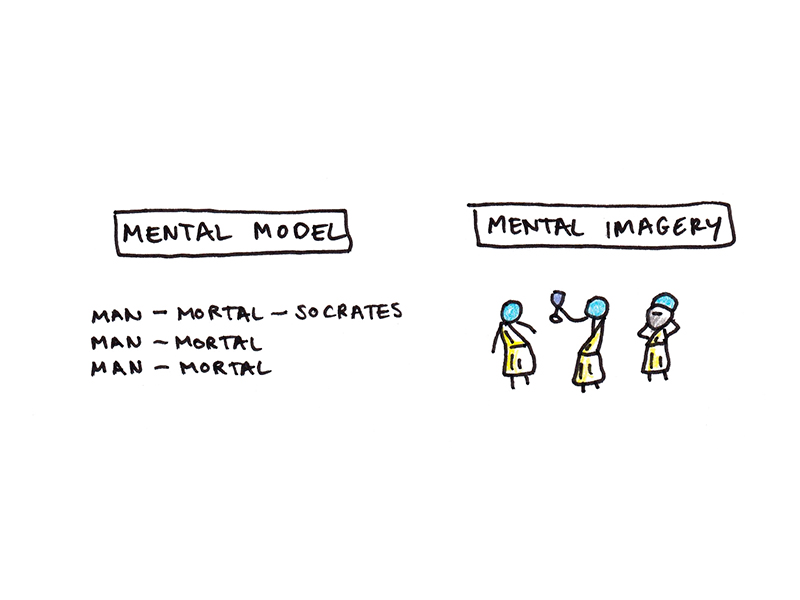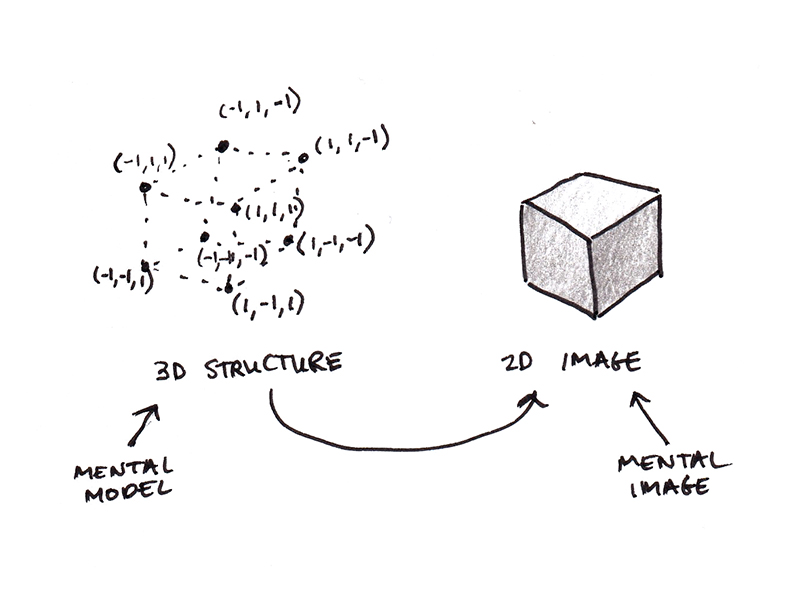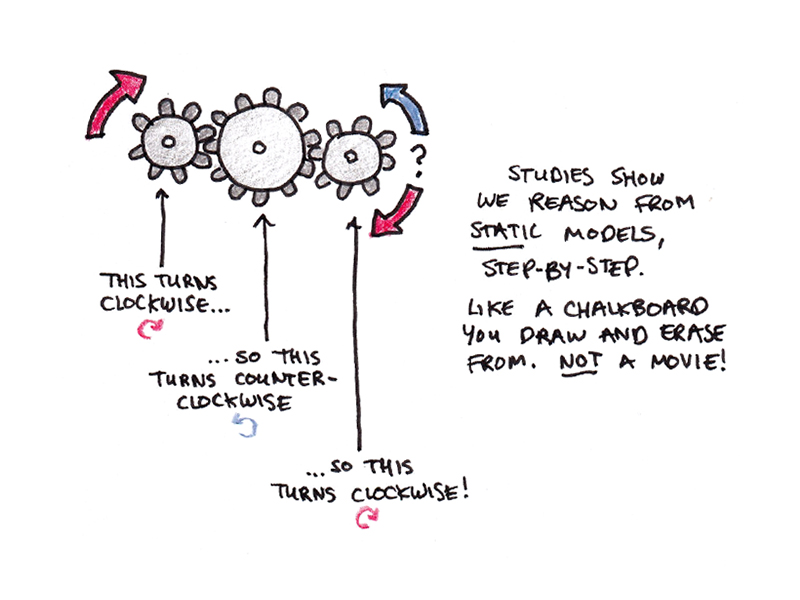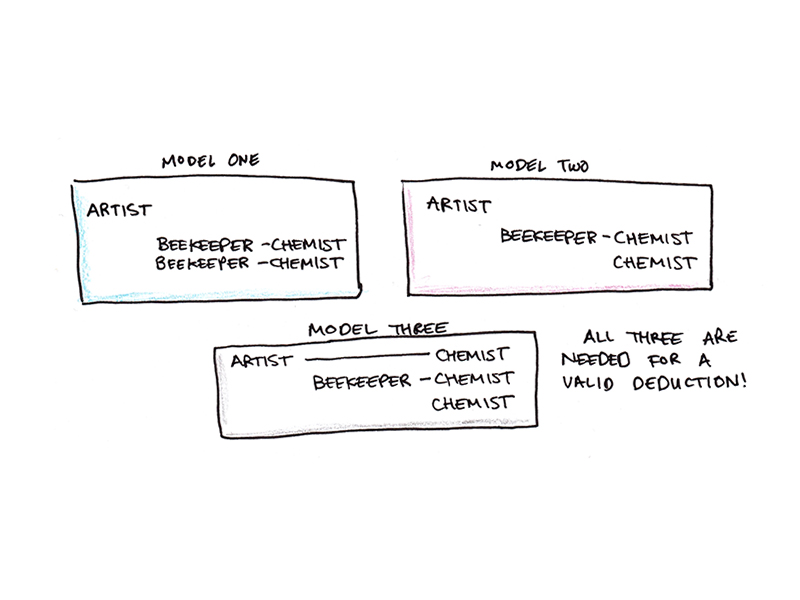Human cause is a puzzling capacity. As a species, we’ve invented logic, arithmetic, science and philosophy. But we undergo from a listing of cognitive biases so lengthy that an whole Wikipedia web page is dedicated to categorizing them.
So which is it: are we wonderful at reasoning or incurably irrational?
Psychologist Philip Johnson-Laird has spent his profession understanding the reply. His idea of psychological fashions explains how now we have the power to cause accurately—and likewise why we steadily fail to take action.
I lately learn Johnson-Laird’s almost 600-page ebook, How We Motive. The ebook weighs in on a powerful number of subjects associated to reasoning:
- Why do some folks cause higher than others? (Psychological fashions require working reminiscence, which is each restricted and varies between people.)
- Why are some puzzles more durable than others? (The extra psychological fashions an accurate inference requires, the more durable it’s to infer the proper reply.)
- Does reasoning differ between cultures? (Johnson-Laird argues the fundamental mechanisms are common, however there could be variations in data or methods.)
- Do folks with psychopathologies cause extra poorly? (It might really be the other! Individuals with obsessive-compulsive dysfunction really cause higher when the content material of the reasoning questions was associated to their obsessions.)
- How does visualization affect reasoning? (Photographs typically happen alongside reasoning, however imagery itself can really make reasoning worse!)
- Can we enhance our capacity to cause? (Johnson-Laird is cautiously optimistic, suggesting a technique primarily based on psychological fashions his analysis discovered dramatically improved efficiency.)
To grasp these questions, and Johnson-Laird’s proposed solutions, let’s stroll by means of what the speculation of psychological fashions argues, the way it differs from some outstanding options, and what that means about how we predict.
What are Psychological Fashions?
To grasp the speculation of psychological fashions, let’s have a look at a fundamental syllogism:
- All males are mortal.
- Socrates is a person.
- Subsequently …
In keeping with Johnson-Laird, we cause by simulating potentialities described by the premises: As we learn the primary premise, we generate a psychological illustration of some males and assign every of them the property “mortal.” As we learn the second premise, we pick considered one of these nameless males and point out that it’s Socrates.
man – mortal – Socrates
man – mortal
man – mortal
…
Inspecting this mannequin, we are able to instantly conclude that Socrates is mortal.
Psychological fashions will not be the identical factor as psychological imagery. It isn’t obligatory to visualise little Athenians in togas, considered one of whom is Socrates, to make the proper inference.

Certainly, a property like “mortal” doesn’t have an instantaneous visible illustration, so it’s not apparent the way it may very well be inferred from a picture.
Psychological fashions are summary, however they’re structured in a means that displays the scenario they characterize.
As an example, Johnson-Laird explains that once we mentally rotate an object, the psychological mannequin we’re rotating is a three-dimensional illustration of the item. Nonetheless, the psychological picture we see in our thoughts’s eye is the picture of that 3D object when considered from a specific vantage level.

Whereas creativeness typically appears like a film we are able to play and rewind, psychological fashions are static. Once we cause a few dynamic scenario, similar to determining the impact of turning a specific gear in a posh machine, we sometimes simulate every part’s impact sequentially. Our reasoning is sort of a static diagram we draw and erase from as we work by means of every step.

Briefly, a psychological mannequin is just not a picture or a film. Relatively, it’s an summary illustration that accommodates one chance primarily based on the knowledge given. We cause by manipulating these representations: including properties, transferring them round and inferring conclusions by instantly inspecting them. The contents of the psychological mannequin are acutely aware, however the mechanisms used to generate and characterize them will not be. Thus, whereas we are able to use psychological fashions to cause, we are able to’t instantly report how they’re organized in our minds like we are able to for psychological imagery.
Why is Reasoning Doable? Why Does it Typically Fail?
I began this ebook assessment by noting the puzzle of human cause: We’re a species that has invented calculus—but steadily fails at fundamental arithmetic.
Think about the next query:
A bat and a ball value one greenback and ten cents. The bat prices one greenback greater than the ball. How a lot does the ball value?
Many individuals instinctively reply with “ten cents,” however that may’t be proper. If the ball value ten cents, the bat would want to value one greenback and ten cents, bringing the overall to $1.20. The proper reply is 5 cents, however many in any other case clever respondents get it incorrect.
Twin-process theories recommend that we use two completely different psychological methods to reply these questions. System 1 is quick, automated and easy. As a result of ten cents and one greenback and ten cents are each in the issue assertion, and one greenback is their distinction, the query instantly provokes a tempting System 1 reply to the query: ten cents.
System 2, in distinction, is sluggish, effortful and calculating. Psychological fashions are a idea of how reasoning occurs on this system. Relatively than the fast, intuitive response given by the primary system, to make use of psychological fashions, we have to mentally assemble the scenario described and examine it to find out the correct reply. Many failures of our reasoning are merely accepting a tempting System 1 reply as an alternative of doing the laborious work of reasoning the query out utilizing System 2.
Reasoning failures don’t happen simply because we depend on deceptive intuitions. They’ll additionally occur when the issue requires us to generate extra psychological fashions than we are able to match inside our restricted working reminiscence.
Some reasoning issues are comparatively simple. Think about the next:
A few of the authors are bakers.
All the bakers are bowlers.
What, if something, follows?
The straightforward deduction, “A few of the authors are bowlers,” happens shortly as a result of the conclusion is clear after solely developing a single psychological mannequin:
creator – baker – bowler
creator – baker – bowler
creator
creator
…
However different issues are harder. Think about:
Not one of the artists is a beekeeper.
All the beekeepers are chemists.
What, if something, follows?
Some folks supply invalid conclusions similar to “Not one of the chemists is an artist,” or state that nothing attention-grabbing follows from these premises. Only a few, in response to Johnson-Laird, draw the proper conclusion, “A few of the chemists will not be artists.”
Why is that this drawback a lot more durable than the primary?
We have to assemble not only one, however three completely different psychological fashions to characterize all of the distinct potentialities implied by the premises. Then, we should examine these psychological fashions to discover a deduction that holds true for all of them.

Johnson-Laird argues that three psychological fashions are on the outer vary of our working reminiscence capability, so most individuals will fail at this reasoning. Nonetheless, we are able to increase our working reminiscence by offloading among the fashions to pencil and paper.
In an intriguing experiment, topics got a pencil and paper and instructed: “Attempt to assemble all the probabilities in step with the given data.” This strategy encourages folks to generate extra fashions and makes it extra possible that they’ll draw an accurate inference.
Johnson-Laird compares the efficiency with reasoning puzzles:
With out the good thing about the mannequin methodology, the individuals had been proper on about two-thirds of the trials, and so they took a mean of twenty-four seconds to guage every inference. With the good thing about the tactic, nonetheless, they had been proper on ninety-five % of the inferences, and so they took a mean of fifteen seconds to guage every inference.
Psychological fashions are cognitively demanding. Thus, we frequently fail to assemble a psychological mannequin and go along with an affordable and quick System 1 response. Or, we get so slowed down in making an attempt to assemble various potentialities that we fail to make a sound conclusion. But our difficulties in reasoning will not be insurmountable. Johnson-Laird explains:
If people err a lot, how can they be rational sufficient to invent logic and arithmetic, and science and expertise? On the coronary heart of human rationality are some easy rules that all of us acknowledge: a conclusion should be the case if it holds in all the probabilities appropriate with the premises. It doesn’t comply with from the premises if there’s a counterexample to it, that’s, a chance that’s in step with the premises, however not with the conclusion. The inspiration of rationality is our data {that a} single counterexample overturns a conclusion about what should be the case. [emphasis added]
Evaluating Psychological Fashions with Various Theories
Psychological fashions are a neat idea, however is the speculation true? Proponents of a given idea can almost at all times level to forcing proof in its favor. Generally, even spurious theories can sound believable, particularly if you happen to haven’t devoted a profession to noticing their flaws.
So, what’s the standing of psychological fashions?
My understanding is that Johnson-Laird’s idea is without doubt one of the main psychological theories of reasoning, despite the fact that it doesn’t have the standing of being a consensus idea (few theories in psychology do). The precept options (which Johnson-Laird spends fairly a couple of pages debating in opposition to) are:
- Formal theories. In these theories, we cause the identical means that logicians do, listening to the logical construction of sentences moderately than their that means.
- Bayesian networks. Bayes’ rule is a means of updating the quantity of confidence in a perception once we encounter new proof. Some theorists argue that our brains implement a model of this rule, permitting us to make inferences with incomplete or unsure data.
- Content material-specific guidelines. As an alternative of a single broad reasoning school, maybe we cause with completely different mechanisms for various kinds of conditions. One outstanding idea, for example, explains reasoning failures as a capability to detect rule violations moderately than a common capacity to cause about conditionals.1
Sensible Takeaways of Psychological Fashions
Inferring sensible ideas from a purely descriptive idea is commonly speculative. Analysis into common problem-solving heuristics inspired many researchers to think about instruction in problem-solving abilities as vital, however we now understand that was in all probability a mistake.
Equally, whereas it’s simple to squint at Johnson-Laird’s outcomes and give you takeaways, a few of these are in all probability illusory. His discovering that imagery might intervene with psychological fashions shouldn’t suggest that suppressing psychological imagery is essentially useful. (Certainly, lots of anecdotal proof in math and physics suggests the other!)
With that warning in thoughts, a couple of tentative takeaways of psychological fashions would possibly embody:
- Use pencil and paper to assemble full fashions for advanced conditions. Programmers, for example, typically introduce bugs once they fail to mentally simulate all of the doable settings for variables and an unanticipated mixture of settings leads to an error. Working by means of all the probabilities with pencil and paper can assist to beat inadequate psychological fashions.
- Information helps reasoning. In keeping with psychological mannequin idea, data modulates our interpretation of logical premises. A whole logical mannequin of “Jim’s both in Rio or he’s in Brazil” consists of the chance that he’s in Rio however not Brazil. Nonetheless, most individuals by no means think about this chance as a result of they know that Rio is in Brazil. Information trims extraneous potentialities and permits for reasoning to proceed with much less value to working reminiscence.
- Use base charges to keep away from pondering psychological fashions have the identical chance of being appropriate. Johnson-Laird argues that we cause about probabilistic occasions by developing potentialities and weighting them equally by default. However this biases our reasoning towards uncommon and strange occasions. Aircraft crashes are simple to visualise, however happen very not often, so we overweigh their chance in comparison with the 1000’s of interchangeable psychological fashions when the airplane lands with out incident. Base charges, the apply of assigning possibilities primarily based on the statistical chance of comparable occasions, can enhance the accuracy of threat calculations.
- Focus on and share your psychological fashions. A weak level of human reasoning is that we battle extra with producing counterexamples than we do with recognizing them. The well-known Wason four-card process methods most individuals, however accuracy improves vastly when individuals are allowed to debate and clarify their selections, as there may be an elevated likelihood of efficiently recognizing a counterexample.
When you’re excited by studying extra about psychological fashions and Johnson-Laird’s idea, I can advocate each his unique 1983 ebook, Psychological Fashions, in addition to his 2006 abstract of the state of the speculation, How We Motive.
Footnotes
- I beforehand reviewed Hugo Mercier and Dan Sperber’s The Enigma of Motive, which suggests a modular idea of cause. Nonetheless, as anthropologists, their idea tries to offer an evolutionary account of reasoning, moderately than explaining the computational mechanisms of underlying reasoning.

